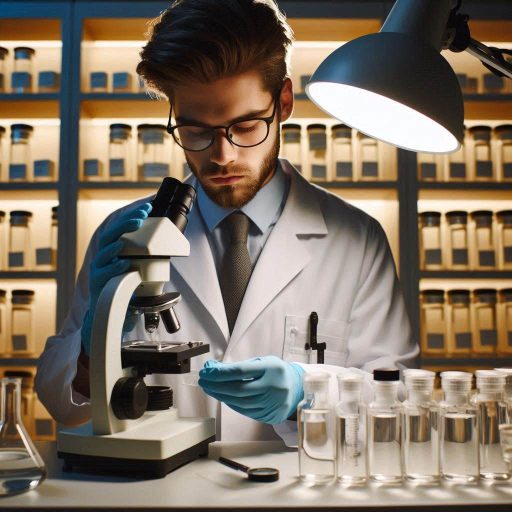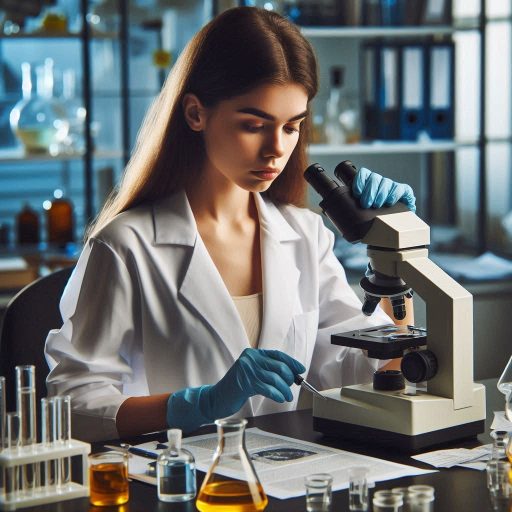Introduction
Forensic science plays a vital role in solving crimes and delivering justice.
It involves the application of scientific methods to analyze evidence from crime scenes.
From fingerprints to DNA, forensic science provides crucial information that helps law enforcement agencies identify suspects and link them to criminal activities.
The importance of forensic science in the justice system cannot be overstated.
It enables investigators to uncover the truth, ensuring that guilty parties are held accountable.
At the same time, it prevents wrongful convictions by providing concrete, scientific evidence.
In many cases, forensic science can mean the difference between freedom and imprisonment, life and death.
Forensic science enhances the fairness and accuracy of judicial proceedings.
By relying on objective data, it reduces the chances of bias and human error in investigations.
Whether it’s through analyzing blood spatter, examining ballistic evidence, or conducting toxicology tests, forensic scientists provide law enforcement with reliable insights.
These insights guide investigations and aid in court trials, ensuring a higher degree of certainty when delivering verdicts.
Solving Crimes
How forensic science plays a crucial role in solving crimes
Forensic science is essential in solving crimes by providing objective evidence that helps identify and convict criminals.
It plays a pivotal role in transforming crime scenes into a goldmine of clues.
One of the most significant contributions of forensic science is the analysis of DNA, fingerprints, and trace evidence.
These forms of evidence offer a high degree of accuracy in linking suspects to crime scenes.
They help law enforcement build cases based on solid, scientific facts rather than circumstantial evidence alone.
How forensic evidence such as DNA, fingerprints, and trace evidence help in identifying and prosecuting criminals
DNA analysis has revolutionized crime-solving by matching biological samples to individuals with near-perfect precision.
Investigators collect hair, skin cells, or blood samples from crime scenes, which are then analyzed in forensic laboratories.
Even the tiniest DNA traces can lead to a breakthrough in a case.
Fingerprints are another powerful tool in forensic science.
Each person‘s fingerprint is unique, and even partial prints can be used to make identifications.
Investigators compare prints found at crime scenes with those in criminal databases.
This method has been used for decades to catch criminals, and its reliability remains strong.
Trace evidence, which includes fibers, gunshot residue, and soil, also plays a critical role in investigations.
Even the smallest materials can offer clues about a suspect‘s movements or involvement.
Examples of high-profile cases where forensic science played a pivotal role in solving crimes
DNA evidence was instrumental in solving the infamous “Golden State Killer” case.
In 2018, decades after the crimes were committed, authorities arrested the suspect by matching DNA from crime scenes to a genealogy database.
Similarly, in the case of the “Night Stalker” serial killer, Richard Ramirez, police identified him through fingerprints left behind at crime scenes.
This forensic evidence led directly to his capture and eventual conviction.
In the Lindbergh baby kidnapping case, forensic scientists matched wood from a ladder at the crime scene to wood found in the suspect‘s attic.
This connection helped convict Bruno Hauptmann of the crime, showing the power of even seemingly insignificant evidence in solving cases.
These high-profile examples demonstrate the undeniable value of forensic science in modern justice systems.
Without these tools, many crimes would remain unsolved, and many criminals would go unpunished.
Forensic science ensures that investigators can uncover the truth through scientific methods.
By making the invisible visible, forensic science turns uncertainty into conviction.
Read: Challenges and Rewards: The Dual Life of an U.S. Environmental Scientist
Ensuring Justice
How forensic science helps ensure justice is served by providing scientific evidence in court
Forensic science plays a critical role in ensuring justice by providing reliable, scientific evidence in court.
This evidence helps clarify facts, identify suspects, and support legal decisions.
By analyzing physical evidence like fingerprints, blood, and DNA, forensic scientists can link suspects to crimes or prove their innocence.
The objectivity of forensic science makes it essential in criminal investigations, removing doubts and emotions from legal proceedings.
The importance of forensic experts testifying and presenting evidence in a clear and understandable manner to juries
One of the key functions of forensic science is the presentation of evidence in court.
Forensic experts often testify to explain their findings, offering juries crucial insights into complex cases.
Their testimony must be clear, concise, and understandable to ensure jurors fully grasp the significance of the evidence presented.
These experts bridge the gap between scientific findings and legal interpretations, ensuring that the facts are both accurate and accessible to non-experts.
A well-delivered testimony can sway a jury‘s understanding and lead to fairer outcomes.
The role of forensic science in exonerating wrongly convicted individuals through DNA analysis
The ability of forensic science to exonerate wrongly convicted individuals is another crucial element in ensuring justice.
DNA analysis has played a pivotal role in this area, proving the innocence of many individuals who were falsely imprisoned.
By reexamining old evidence, forensic scientists have helped overturn wrongful convictions, often years or decades after the original trials.
This ability to correct errors in the justice system highlights the profound impact of forensic science on fairness and truth.
Forensic experts must adhere to the highest standards of accuracy and objectivity when presenting evidence.
Their findings often determine the outcome of a case, directly influencing the fate of those involved.
Proper forensic procedures help ensure that the innocent are protected, and the guilty are held accountable.
Through this commitment to precision, forensic science upholds the integrity of the legal system.
In cases where forensic evidence exonerates the innocent, it restores faith in justice.
DNA evidence, in particular, has revolutionized the way courts approach criminal cases.
It serves as a powerful tool for revealing the truth and preventing future miscarriages of justice.
The role of forensic science in clearing the names of the wrongfully convicted underscores its importance in ensuring that justice is served in every case.
Forensic science has become an indispensable part of modern legal systems.
Its ability to provide irrefutable, scientific proof helps guarantee that justice is fair and unbiased.
From securing convictions to freeing the innocent, forensic science continues to serve as a vital pillar of truth in the pursuit of justice.
Read: Job Market Trends: Future of Chemistry Jobs in America
Crime Scene Investigation
The significance of proper crime scene investigation in collecting and preserving evidence
Proper crime scene investigation is crucial for ensuring justice in criminal cases.
Investigators must meticulously collect and preserve evidence to avoid contamination.
Evidence collected from a crime scene often plays a decisive role in determining guilt or innocence.
Any mishandling of evidence can lead to wrongful convictions or acquittals, compromising the entire justice process.
The techniques and tools used in crime scene investigation, such as blood spatter analysis, ballistics, and footprint analysis
One of the key techniques used in crime scene investigation is blood spatter analysis.
This technique helps determine how a violent crime occurred by studying the blood‘s trajectory.
Investigators can identify the type of weapon used, the force applied, and the position of the victim and assailant during the crime.
Proper analysis of blood patterns can provide critical insights into what truly happened at the scene.
Ballistics analysis is another vital tool in crime scene investigation.
This technique involves studying bullets, firearms, and cartridge cases found at a crime scene.
Through ballistics analysis, investigators can match a bullet to the gun used in a crime.
This matching process can connect a suspect to the crime and provide essential evidence to support a conviction.
Footprint analysis also plays a significant role in solving crimes.
Footprints found at crime scenes can reveal critical information such as the suspect‘s height, weight, and movement patterns.
Investigators can use this data to track the suspect‘s movements within the crime scene and even identify their point of entry or exit.
The ability to analyze footprints has helped solve cases that otherwise would have gone cold.
Examples of how meticulous crime scene investigation has helped in solving complex cases
A prime example of the importance of crime scene investigation is the O.J. Simpson trial.
Meticulous analysis of evidence such as blood spatter, gloves, and shoeprints was pivotal in building the case.
However, improper handling of evidence during the investigation led to doubts about its integrity.
This example highlights how critical the proper collection and preservation of evidence are in ensuring a fair trial.
In contrast, crime scene investigation was instrumental in solving the Boston Strangler case.
Investigators carefully analyzed DNA evidence collected from the crime scene, which led to the conviction of Albert DeSalvo.
Their attention to detail in collecting and preserving DNA helped crack this notorious case years after the crimes occurred.
Essentially, crime scene investigation plays an irreplaceable role in delivering justice.
The careful collection, preservation, and analysis of evidence are essential in solving crimes.
By using advanced techniques such as blood spatter analysis, ballistics, and footprint analysis, investigators can uncover critical information that helps bring criminals to justice and prevents wrongful convictions.
Read: Challenges and Rewards: Navigating the Chemist Career Path

Identifying Unknown Victims
How Forensic Science Is Used to Identify Unknown Victims, Such as Those in Mass Disasters or Cold Cases
Forensic science plays a crucial role in identifying unknown victims, especially in mass disasters or cold cases.
After tragic events like plane crashes or natural disasters, forensic experts work tirelessly to identify human remains.
This process is vital for both humanitarian reasons and criminal investigations.
Forensic anthropologists and odontologists are key players in this identification process.
The Process of Forensic Anthropology and Odontology in Identifying Human Remains
Forensic anthropology involves examining human skeletal remains to determine the identity of victims.
Experts analyze bones to estimate the age, sex, height, and ancestry of the deceased.
This information provides crucial clues, especially when remains are found long after death.
Forensic anthropologists can also detect signs of trauma or disease that may help identify the victim or understand the cause of death.
Odontology, or forensic dentistry, focuses on analyzing dental records to confirm a person’s identity.
Teeth, being the hardest part of the body, often survive extreme conditions like fire or decomposition.
Forensic odontologists compare the dental remains of victims with existing dental records to establish positive identification.
This method is particularly effective in cases where other physical features are unrecognizable.
The Importance of Victim Identification in Bringing Closure to Families and Solving Crimes
Both forensic anthropology and odontology are essential in mass casualty events.
In large-scale disasters, where multiple victims are involved, these techniques allow experts to sort and identify remains quickly and accurately.
This identification helps to bring closure to families, who can finally know the fate of their loved ones.
The process is deeply emotional, providing families with a sense of peace and a chance to properly mourn.
Identifying unknown victims also aids in solving crimes, especially in cold cases.
Many unsolved cases involve unidentified human remains, which can stagnate investigations.
However, forensic science offers hope in these situations.
With advances in DNA technology, even decades-old remains can now be tested, providing new leads for investigators.
Once an unknown victim is identified, law enforcement can pursue new angles in the investigation, potentially solving long-dormant cases.
Victim identification has far-reaching consequences for justice.
In addition to solving crimes, it ensures that each victim receives recognition and dignity, preventing them from becoming mere statistics.
By giving a name to the nameless, forensic science restores humanity to victims and strengthens the justice system.
Families are no longer left in limbo, and investigators are empowered to continue their work.
Read: Diverse Career Paths: From Chemist to Patent Attorney in the US
Discover More: Collaborating with Other Scientists: Interdisciplinary Research
Analyzing Digital Evidence
Digital forensics plays a critical role in modern criminal investigations.
It focuses on retrieving and analyzing electronic devices and data.
Forensic experts examine computers, smartphones, and other digital devices to uncover crucial evidence.
Emails, text messages, social media accounts, and computer files often provide key information for solving cases.
The Role of Digital Forensics
Forensic experts use specialized tools to access and extract digital data.
This can involve recovering deleted files or analyzing encrypted information.
They trace communication patterns, find hidden files, and piece together activity logs from devices.
This process helps law enforcement agencies understand what happened before, during, or after a crime.
One of the most common uses of digital forensics is in cybercrime investigations.
Hackers, cybercriminals, and fraudsters leave traces of their activities online.
Digital forensic experts can follow these digital footprints to identify perpetrators.
For instance, they can analyze IP addresses, track login times, or decrypt communications used in illegal operations.
Transform Your Career Today
Unlock a personalized career strategy that drives real results. Get tailored advice and a roadmap designed just for you.
Start NowRetrieving and Analyzing Digital Evidence
However, digital forensics is not limited to cybercrime cases.
It is essential in many types of criminal investigations.
In cases of fraud, theft, or even murder, digital evidence can provide critical clues.
Text messages, emails, and phone call records may reveal a suspect‘s movements, motives, or accomplices.
Retrieving and analyzing digital evidence requires specialized expertise.
Digital forensic experts must stay up to date with the latest tools and techniques.
They need to ensure the integrity of the evidence they handle.
If they mishandle evidence, it could be deemed inadmissible in court.
To prevent this, forensic experts follow strict protocols during their investigations.
Challenges and Advancements in Digital Forensics
One of the challenges in digital forensics is the rapid evolution of technology.
As devices become more advanced, criminals find new ways to cover their tracks.
Encryption tools, anonymizing software, and data-wiping programs make it harder to access evidence.
Digital forensic experts must constantly update their skills to keep up with these developments.
Another challenge is the sheer volume of data.
Investigators often have to sift through vast amounts of information from multiple devices.
Identifying relevant pieces of evidence from this digital mountain can be time-consuming and complex.
Advanced tools and artificial intelligence are helping streamline this process.
Despite these challenges, digital forensics has made significant advancements.
New software tools can recover deleted or hidden files more effectively than ever before.
Machine learning algorithms are helping forensic experts analyze large datasets faster and with more accuracy.
These advancements are crucial in combating cybercrime and solving complex cases.
Most importantly, digital forensics plays a vital role in modern justice.
Its ability to uncover digital evidence is essential for solving crimes in an increasingly digital world.
Uncover the Details: Impact of Hydrology on Agriculture and Irrigation
See Related Content: Seismology Conferences and Networking Events
Expert Testimony
Importance of Unbiased and Accurate Testimony
Forensic science plays a crucial role in the courtroom, particularly through expert testimony.
Forensic experts provide unbiased and accurate analysis, which can significantly impact the outcome of trials.
Their insights often guide judges and juries in understanding complex scientific evidence.
This testimony serves as a bridge between technical information and legal standards, ensuring that justice prevails.
Qualifications and Training of Forensic Experts
To become a forensic expert, individuals must meet specific qualifications and undergo extensive training.
Different fields, such as DNA analysis, toxicology, and ballistics, require distinct educational backgrounds.
For example, DNA analysts often hold advanced degrees in biology or genetics.
They must master complex techniques such as polymerase chain reaction (PCR) and DNA sequencing.
Toxicologists study the effects of chemicals on living organisms.
They typically possess degrees in chemistry or pharmacology.
Training in toxicology involves understanding how substances interact within the body.
This knowledge is vital for interpreting evidence related to drug overdoses or poisoning cases.
Ballistics experts focus on firearms and ammunition analysis.
These specialists often have backgrounds in engineering or physics.
They must learn to examine bullet trajectories, gunshot residue, and weapon functionalities.
This detailed understanding aids law enforcement in solving crimes involving firearms.
Ethical Responsibilities of Forensic Experts
Regardless of their specialty, forensic experts share common ethical responsibilities.
They must remain impartial and provide objective opinions based on evidence.
Their primary goal is to assist the court, not to advocate for either side.
This objectivity helps uphold the integrity of the justice system.
Forensic experts must also communicate their findings clearly and understandably.
Jargon can confuse juries and judges, making effective communication essential.
By breaking down complex concepts, experts can ensure that their testimony is accessible to all.
In addition to clear communication, forensic experts must maintain rigorous standards in their work.
This includes following established protocols and documenting their procedures meticulously.
Such diligence is crucial for validating their findings in court.
Any deviation from standard practices can lead to questions about the reliability of their testimony.
Furthermore, forensic experts should participate in ongoing education and training.
Science evolves rapidly, and staying updated on new techniques and technologies is vital.
This commitment to continuous learning enhances their credibility and effectiveness in court.
Basically, the importance of expert testimony in forensic science cannot be overstated.
These professionals provide invaluable insights that shape the judicial process.
Their qualifications, training, and ethical responsibilities ensure that justice is served effectively.
Through their work, forensic experts help maintain public trust in the legal system.
See Related Content: Toxicology Research: Current Trends and Innovations
Conclusion
In this blog post, we explored the vital role of forensic science in the justice system.
We discussed how forensic evidence assists law enforcement agencies in solving crimes.
It provides critical insights that can lead to the identification of suspects.
Through DNA analysis, fingerprinting, and ballistics, forensic science delivers essential data for investigations.
We also highlighted the impact of forensic science on court cases.
It helps attorneys present compelling evidence to judges and juries.
This evidence often determines the outcome of trials.
Accurate forensic analysis strengthens the integrity of the judicial process.
It ensures that justice is served based on reliable information.
Furthermore, we examined how forensic science evolves with technological advancements.
New methods enhance the accuracy of crime scene analysis.
Innovations, like digital forensics, enable investigators to examine electronic devices for evidence.
These developments contribute to a more thorough understanding of criminal activities.
We cannot overlook the significance of forensic science in preventing wrongful convictions.
By relying on scientific evidence, courts can avoid errors that may lead to unjust sentences.
This aspect is crucial in protecting innocent individuals from being punished for crimes they did not commit.
[E-Books for Sale]
The Big Book of 500 High-Paying Jobs in America: Unlock Your Earning Potential
$19.99 • 500 High-Paying Jobs • 330 pages
Explore 500 high-paying jobs in America and learn how to boost your career, earn more, and achieve success!
See All 500 High-Paying Jobs of this E-Book
1001 Professions Without a Degree: High-Paying American Jobs You Can Start Now
$19.99 • 1001 Professions Without a Degree • 174 pages
Discover 1001 high-paying jobs without a degree! Unlock career tips, skills, and success strategies for just $19.99!




